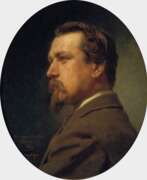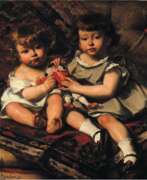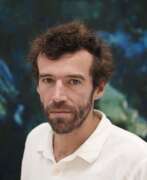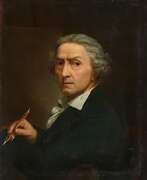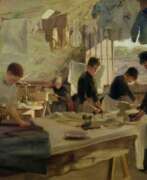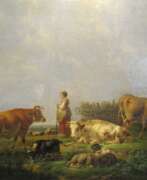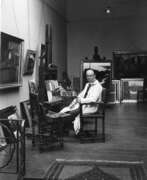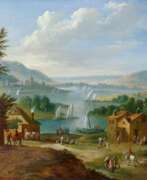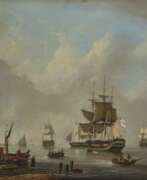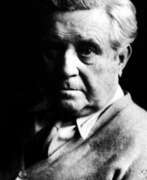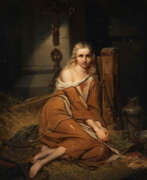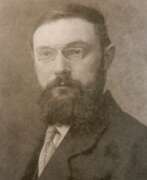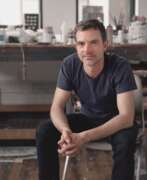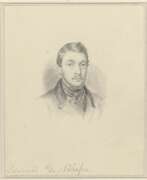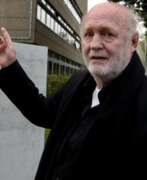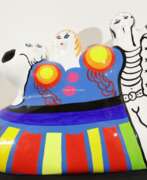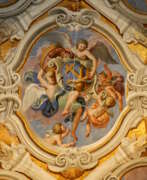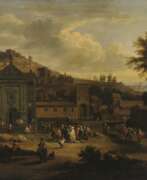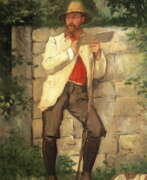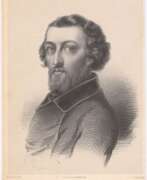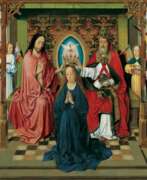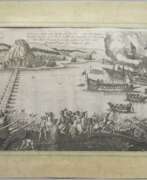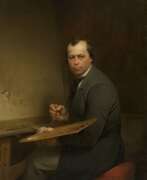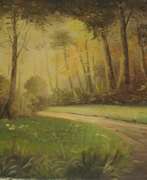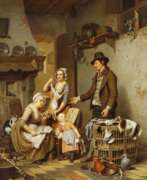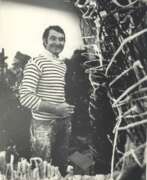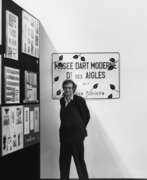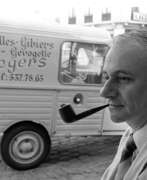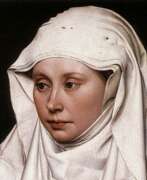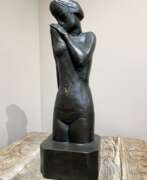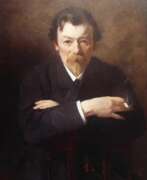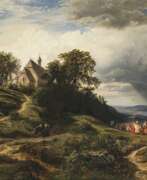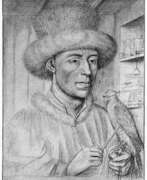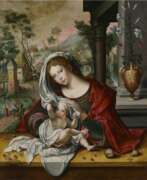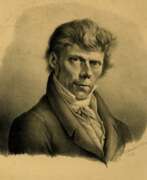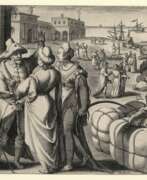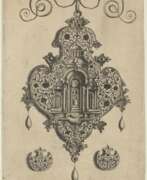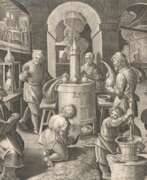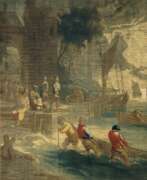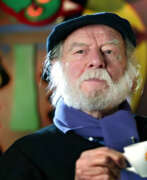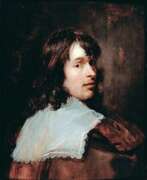Belgium
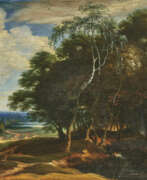

Lucas Achtschellinck was a Flemish landscape painter. He is counted among the landscape painters active in Brussels referred to as the School of Painters of the Sonian Forest who all shared an interest in depicting scenes set in the Sonian Forest, which is located near Brussels.


Francis Alÿs is a Belgian-born, Mexico-based artist.
His work emerges in the interdisciplinary space of art, architecture, and social practice. In 1986, Alÿs left behind his profession as an architect and relocated to Mexico City.
He has created a diverse body of artwork and performance art that explores urban tensions and geopolitics. Employing a broad range of media, from painting to performance, his works examine the tension between politics and poetics, individual action and impotence.
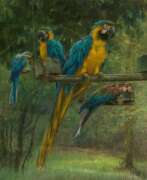

Berthe Constance Ursule Art was a Belgian still life painter. She was trained by Alfred Stevens and advised by Franz Binjé. Berthe Art exhibited her work at the Palace of Fine Arts and The Woman's Building at the 1893 World's Columbian Exposition in Chicago, Illinois. She became a member of the Brussels-based club called Cercle des Femmes Peintres which was active 1888–1893. They were the Belgian equivalent of the French Union des Femmes Peintres et Sculpteurs. She began a Brussels gallery in 1911 together with some friends from the (by then defunct) Circle of Women Painters. The gallery was called the Galerie Lyceum.
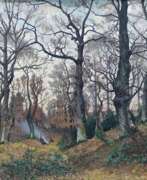

Alphonse Asselbergs was a Belgian painter, primarily of landscapes and forest scenes. Much of his training in art came from Huberti, and he would travel with him in the area around Namur. It was there he befriended Théodore T'Scharner, a student of Ferdinand Marinus, with whom he would go on painting expeditions in the Ardennes. In the summer of 1866, he took an extended trip with Huberti, to the artists' colony at Anseremme, where he was first exposed to the concept of painting en plein aire. In 1867 year he joined the painters at the artists' colony in Tervuren, where he stayed regularly until 1871. The Tervuren Schhol later became known as the Belgian equivalent of the Barbizon School. By 1868, he was receiving good reviews at the salon in Ghent. That same year, he became one of the co-founders of the Société Libre des Beaux-Arts. By 1869, he was exhibiting in Brussels. From 1873 to 1874, he visited Algeria with the watercolorist, Arthur Bouvier. This resulted in a number of Orientalist canvases.
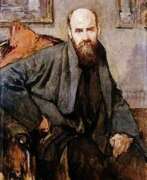

Albert Baertsoen was a Belgian painter, pastellist and graphic artist. His debut as a painter came in 1887, when he participated in an exhibition in Brussels held by the secessionist group l'Essor. He continued his studies in Paris, at the art school of Alfred Philippe Roll, and exhibited at the Salon in 1889. In 1894, he helped found the "Cercle des Beaux-Arts d'Ostende". From 1896 to 1901, he continued to exhibit throughout Europe, winning several Gold Medals. In 1913, he served as a member of the art jury for the Ghent World's Fair. During World War I, he lived in London, returning to Ghent in 1919. That same year, he was appointed a member of the Royal Academy of Belgium.
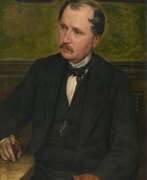

Alphonse Balat, full name Alphonse Hubert François Balat, was a Belgian architect.
He studied at the Academy of Namur and earned an architect's degree from the Academy of Antwerp in 1838. Balat's neo-Renaissance work soon came to the attention of the high nobility of Brussels, and he began to receive prestigious commissions.
In 1856, he built the city palace (Hotel) of the Marquis of Asch. After Leopold II ascended to the throne in 1865, Balat became his chief architect. He designed a number of projects for the luxurious reception areas of the Royal Palace of Belgium, such as the Throne Room, the Grand Staircase and the Grand Gallery. Alphonse Balat's most successful architectural project is considered to be the Lacuna Royal Greenhouses, where he pioneered the use of floral motifs, which later became the basis of the Art Nouveau style.
Alphonse Balat also built a large number of private residences during his career.
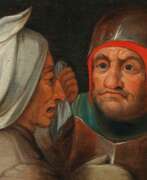

Pieter Balten or Pieter Custodis was a Flemish Renaissance painter, etcher, draftsman, publisher, and poet. He was a member of the Guild of St. Luke in Antwerp.
Pieter Balten is considered one of the pioneers of realistic depictions of village life, often comic. He also painted religious compositions, landscapes and painted tronies - portraits with comic and even caricatured facial images.


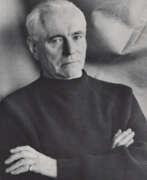

Marcel-Louis Baugniet was a Belgian painter, theorist, furniture designer, creator of posters, costumes and stage sets, and one of the main advocates of the concept of pure plasticity.
He studied painting at the Royal Academy of Fine Arts in Brussels, where he communicated with Paul Delvaux, René Magritte, Victor Servranck and Pierre-Louis Flouquet.


Euphrosine Beernaert was a Belgian landscape painter. She studied under Pierre-Louis Kuhnen in Brussels. She travelled in Germany, France, and Italy, and exhibited landscapes at Brussels, Antwerp, and Paris, her favorite subjects being Dutch. In 1873, she won a medal at Vienna; in 1875, a gold medal at the Brussels Salon; and still other medals at Philadelphia, Sydney and Teplitz. She was made Chevalier de l'Ordre de Leopold in 1881.
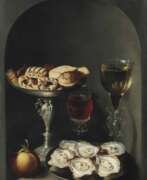

Osias Beert the Elder, a Flemish painter born around 1580 and active until his death in 1623, was a key figure in the development of still life painting in Northern Europe. His work, primarily focused on flower and banquet (or "breakfast") pieces, showcased a pioneering approach to these genres, setting a precedent for future artists.
Beert's technique involved painting on oak panels and copper, employing a glazing method that layered very fluid oil paints to achieve transparency and a rich color palette. This method allowed him to create still lifes that were not only visually appealing but also rich in detail and depth. He was known for his intricate compositions that often featured a high viewpoint and compact arrangements, providing a better sense of spatial coherence in his later works.
Despite the significant impact of his work, only a few signed pieces by Beert are known, making the attribution of his works challenging. His influence extended to his pupils and his nephew Frans Ykens, as well as other Antwerp artists such as Jacob Foppens van Es and Jacob van Hulsdonck, indicating his pivotal role in the early still life painting tradition in Flanders.
For collectors and experts in art and antiques, Osias Beert the Elder's contributions to the evolution of still life painting represent an essential chapter in the history of art. His ability to depict the transient beauty of flowers and the lavish detail of banquet scenes continues to captivate audiences and serves as a testament to his skill and creativity.
To delve deeper into the fascinating work of Osias Beert the Elder and to stay informed about new discoveries or auction events related to his oeuvre, consider signing up for updates tailored to enthusiasts of art history and antique collections. This subscription will ensure you are well-informed about the latest developments and opportunities related to this influential artist's work.
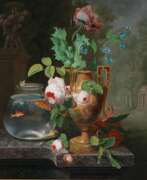

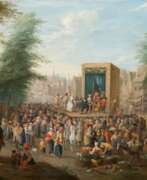



Joachim Beuckelaer, a masterful Flemish painter born around 1533, was renowned for his intricate market and kitchen scenes, which were abundant with detailed depictions of food and household items. His unique approach combined everyday life with religious narratives, often situating biblical episodes within the backdrop of bustling market scenes or domestic settings. This innovative blend of the mundane with the spiritual set the stage for future developments in Dutch and Flemish painting.
Beuckelaer's influence extended beyond his immediate geographic locale, impacting artists across Europe, from Italy to Spain, heralding a new appreciation for kitchen and market scenes that would flourish in seventeenth-century painting. His works were not only appreciated for their aesthetic and technical mastery but also for their ability to capture the essence of sixteenth-century Antwerp life, from the vibrancy of its markets to the intimacy of its kitchens.
His oeuvre includes a variety of subjects, from purely religious works to those that focus solely on still-life elements without any human figures, indicating his versatility and innovation as an artist. Beuckelaer was known for employing techniques that allowed him to efficiently reuse compositions, showcasing his ability to adapt and repurpose his work to meet the demands of his patrons.
Notable works by Beuckelaer, such as the "Four Elements" series, now housed in the National Gallery, London, demonstrate his skill in merging complex allegories with detailed observations from nature and daily life. These paintings are celebrated for their depth of detail and the way they foreground the role of women in the culinary and market spheres.
For collectors and experts in art and antiques, Joachim Beuckelaer's paintings offer a fascinating glimpse into the cultural and social dynamics of the sixteenth century, as well as the evolution of still-life and genre painting in the early modern period. His ability to weave together the secular and sacred, the abundant and the everyday, marks him as a significant figure in the history of art.
To remain informed about the latest discoveries, sales, and auction events related to Joachim Beuckelaer, consider signing up for updates. This subscription is an invaluable resource for those keen to explore the depths of Flemish painting and its enduring influence on European art history.


François Joseph Binjé, known as Frans or Franz Binjé (dit Frans ou Franz Binjé) was a landscape painter who depicted rural views. He painted in oil, watercolour and pastel.
François Joseph Binjé was self-taught, later becoming a teacher. His realistic style was eventually influenced by Impressionism. He participated in regional exhibitions from 1874, as well as international exhibitions (Berlin 1869 and Paris 1900). Two of his works appeared in the catalogue of the Giroux Gallery in 1927. He is widely represented in the collections of the Walloon Art Museum in Liège.
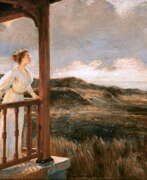

Ernest-Stanislas Blanc-Garin was a Belgian portrait and landscape painter. He came to Brussels in 1863 and became a student of Jean-François Portaels. After that he went to Paris and joined the studio of Alexandre Cabanel, became a student of the Ecole des Beaux-Arts. He took part in the 1867 Prix de Rome competition (“The Murder of Laïus by Oedipus”) and received an honorable mention at this competition in 1868. After a stay in Italy, he settled permanently in Brussels in 1871 and opened a private painting academy. In 1891 he became one of the founding members of the Société des Beaux-Arts de Bruxelles.
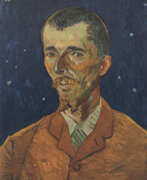

Eugène Boch was a Belgian painter, celebrated for his vibrant contributions to the Post-Impressionist movement. Boch was part of a prominent family known for their fine china business, Villeroy & Boch. He pursued his passion for art in Paris, studying under notable teachers such as Léon Bonnat and Fernand Cormon.
Eugène Boch's artistry is marked by his distinct style and use of color, which earned him spots in prestigious exhibitions like the Salon in Paris during the 1880s. His works, characterized by their emotional depth and innovative techniques, reflect the bold spirit of the Post-Impressionist era. He was not only a painter but also a visionary, whose works resonated with the aesthetic shifts of his time.
One of Eugène Boch's most notable associations was with Vincent van Gogh, who painted Boch in the famous portrait "The Poet," which Van Gogh described as a vision of idealistic and artistic purity. This painting is now housed at the Musée d'Orsay, symbolizing their profound connection and mutual respect. Boch's own works, like "The Red Roofs," demonstrate his unique ability to blend reality with his visionary outlook, showcasing scenes filled with vivid colors and dynamic compositions.
Eugène Boch's legacy extends beyond his paintings. Upon his death in 1941, he left a significant impact on the cultural heritage of Europe, influencing future generations of artists. His works continue to be celebrated in major museums and galleries, reminding us of his pivotal role in the development of modern art.
For collectors and experts in art and antiques, Boch's works offer a timeless exploration of Post-Impressionist vibrancy. Sign up for updates and stay informed about new sales and auction events featuring Eugène Boch’s timeless works, ensuring you never miss an opportunity to own a piece of art history.
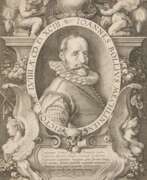

Hans Bol was a Flemish artist renowned for his miniature paintings and prints. Born in Mechelen, Bol was a pivotal figure in the transition from the world landscape tradition to a more realistic portrayal of nature. His early works as a 'water-verwer' offered affordable wall decorations but were susceptible to copying. This led him to create intricate miniatures on parchment, a medium less easily replicated.
Bol's influence on landscape art in the Low Countries is significant. His realistic landscapes, often featuring biblical scenes or daily life, showed a departure from imaginary landscapes, which was common at the time. This shift was partly due to the influence of Pieter Bruegel the Elder. Bol's completion of the Four Seasons series, initially started by Bruegel, established him as a master of landscape art, blending detailed observation with imaginative elements.
Notably, Bol's works are present in prestigious institutions such as the Metropolitan Museum of Art, where pieces like "The Prodigal Son" and various landscapes reflect his mastery of pen, ink, and wash. His artworks, like the "Landscape with a View of Antwerp," stand testament to his skill in capturing the essence of the Dutch landscape, influencing a generation of Dutch painters.
For collectors, auctioneers, and art connoisseurs, Hans Bol's legacy offers a glimpse into the evolution of landscape painting. His works not only adorned the homes of the affluent during his time but continue to be celebrated for their historical and artistic value.
To stay informed about sales and auction events featuring Hans Bol's masterpieces, sign up for updates. By subscribing, you will receive notifications only for new product sales and auction events related to this eminent artist, ensuring you don't miss the opportunity to own a piece of art history.


Schelte Adamsz Bolswert was a leading Dutch engraver, noted for his works after Rubens and Van Dyck. Both he and his older brother, Boetius à Bolswert, worked in Amsterdam and Haarlem before settling in Antwerp. For the last five years of his life Boetius worked exclusively on engravings after Rubens. Bolswert's plates were worked entirely with the graver, and he does not seem to have made any use of the drypoint. The freedom which this excellent artist handled the graver, the picturesque roughness of etching, which he could imitate without any other assisting instrument, and the ability he possessed of distinguishing the different masses of colours, have always been admired by the conoisseurs".
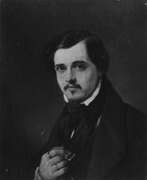

Charles Bonier was a Belgian artist, celebrated for his contributions to painting, lithography, and aquarelle. Born in Brussels in 1814, Baugniet's artistic journey began at the Académie Royale des Beaux-Arts, where he honed his skills under notable instructors. His early forays into lithography, starting in 1827, set the stage for a distinguished career that would intertwine with the cultural and historical fabric of the 19th century.
Charles Boniers artistry gained prominence with his lithographic portraits, particularly those featured in L'Artiste magazine in 1833. His collaboration on a series of portraits for the Belgian House of Representatives further solidified his reputation. However, it was his court appointment as a painter to the Belgian Royal Family in 1841 that marked a significant milestone, elevating his status and expanding his influence beyond Belgian borders.
In 1843, Charles Boniers talents took him to London, where he became a sought-after portraitist among the elite, capturing the likenesses of figures like Prince Albert, Charles Dickens, and Hector Berlioz. His move to Paris in 1860 coincided with the rise of photography, yet Bonier adeptly transitioned, focusing on paintings that reflected the Second French Empire's elegance.
Today, collectors and art enthusiasts cherish Charles Boniers works for their historical value and artistic merit. His ability to capture the essence of his era and subjects makes his art a prized possession in galleries and collections worldwide.
For those fascinated by the intersection of art, culture, and history, Charles Boniers oeuvre offers a compelling glimpse into the 19th century's artistic and societal landscapes. To stay informed about new discoveries and auction events related to Charles Boniers works, sign up for updates and delve deeper into the legacy of this remarkable artist.
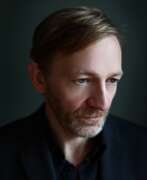

Michaël Borremans is a Belgian painter and filmmaker who lives and works in Ghent. His painting technique draws on 18th-century art as well as the works of Édouard Manet and Degas. The artist also cites the Spanish court painter Diego Velázquez as an important influence. In recent years, he has been using photographs he has made himself or made-to-order sculptures as the basis for his paintings.


Ambrosius Bosschaert the Elder, born on January 18, 1573, in Antwerp and passing away in 1621 in The Hague, was a pivotal figure in the Dutch Golden Age of painting. Recognized for his remarkable contributions to the art of still life painting, particularly floral arrangements, Bosschaert founded a dynasty of painters who furthered his intricate style of floral and fruit painting. This legacy cemented Middelburg's status as a premier center for flower painting in the Dutch Republic.
Fleeing to the Northern Netherlands due to religious persecution, Bosschaert and his family settled in Middelburg around 1587, where he would spend the majority of his career. His paintings, known for their precision and vibrant composition, reflect the era's fascination with botany, merging scientific accuracy with artistic beauty. Bosschaert's work was not only celebrated for its aesthetic appeal but also for its symbolic and sometimes religious meanings, often painted on small copper canvases that highlighted the meticulous detail of each flower.
His influence and techniques were continued by his three sons and his brother-in-law, Balthasar van der Ast, ensuring the Bosschaert style flourished through the mid-17th century. Bosschaert's approach to flower painting laid the groundwork for what would become a defining genre in Dutch art, showcasing not just the beauty of nature but the wealth and intellectual curiosity of the era.
For collectors and experts in art and antiques, Ambrosius Bosschaert the Elder's contributions to still life and flower painting remain invaluable. His legacy is preserved in the meticulous bouquets that capture the transient beauty of flora, making his works sought after for both their historical significance and timeless appeal.
To stay informed about new discoveries, sales, and auction events related to Ambrosius Bosschaert the Elder, signing up for updates from art galleries and auction houses is recommended. This ensures access to the latest information and opportunities to acquire works by this master of still life painting.
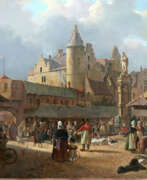

François-Antoine Bossuet was a painter and draughtsman of the Belgian school. Bossuet is known for his depictions of the landscapes, cities and monuments of Spain and Italy, with an emphasis on historic places, occasionally with genre scenes of everyday life. He is noted for the excellence of perspective in his paintings. He was professor at the Academy of Fine Arts in Brussels, from 1855 until 1876. His works may be seen in the Royal Museum of Fine Arts, Antwerp, the Royal Museums of Fine Arts of Belgium in Brussels, and the Victoria and Albert Museum in London.
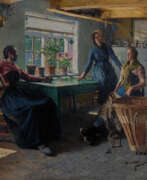

Aloïs Boudry was a Belgian painter known for his portraits, still lifes and interiors. He studied at the art schools in Ypres and Roeselare and finished at the Royal Academy of Fine Arts (Antwerp). In 1885, he joined "Als ik Kan" (If I Can), an association of visual artists devoted to preserving traditional methods. He participated in the exposition "Brussels International 1910", where he won a silver medal. When the seaside resort of Knokke-Heist began a promotional campaign in 1913, he designed the posters, which became well-known. At the outbreak of World War I, he fled to England and established himself as a portraitist. Wherever he was, he sought out humble people as the subjects for his paintings. His depictions of the fisherman of Nieuwpoort are especially popular. Many of them can be seen at the National Fishery Museum in Oostduinkerke.


Paul Boudry is a Flemish painter from Antwerp. He painted for three years under the direction of Isidore Opsomer. But it was from his master Walter Vaes that he received refinement. He admired the Flemish flower painters of the 17th century and carefully studied their technique. The freshness and beauty of the colors of its flowers owes them a lot. To achieve great precision, he sometimes used brushes with a single hair. Paul Boudry was a professor at the Academy of Fine Arts in Berchem. We owe him a very limited number of exhibitions. This did not prevent him from being known and recognized by amateurs who came to visit him directly at his studio. He is most famous for his portraits and drawings of children's heads and for his very precise flowers. His meticulousness brings him closer to the line of Boudry painters: his grandfather Aloïs Boudry and his father Robert Boudry.
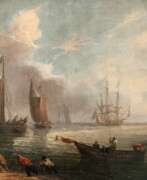

Pieter Bout was a Flemish painter, draughtsman and etcher. He is known mainly for his landscapes, city, coast and country views and architectural scenes painted in a style reminiscent of earlier Flemish masters such as Jan Brueghel the Elder.


Frank William Brangwyn was a Welsh artist, painter, watercolourist, printmaker, illustrator, and designer.
As well as paintings and drawings, he produced designs for stained glass, furniture, ceramics, glass tableware, buildings and interiors, was a lithographer and woodcutter and was a book illustrator. It has been estimated that during his lifetime Brangwyn produced over 12,000 works. His mural commissions would cover over 22,000 sq ft of canvas, he painted over 1,000 oils, over 660 mixed media works (watercolours, gouache), over 500 etchings, about 400 wood-engravings and woodcuts, 280 lithographs, 40 architectural and interior designs, 230 designs for items of furniture and 20 stained glass panels and windows.


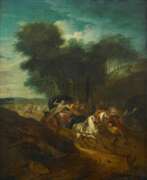

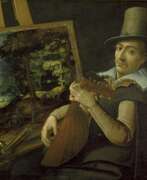

Paul Bril was a prominent Flemish painter, best known for his significant contributions to landscape painting. Born around 1554 in Antwerp, he later moved to Rome, where he became a central figure in the art scene, influencing the Italian and Northern European landscape painting traditions.
Paul Bril's early works were steeped in the Flemish manner, exhibiting a picturesque arrangement of landscape elements with dramatic contrasts of light and dark. His style evolved during his stay in Rome, influenced by the work of Annibale Carracci and Adam Elsheimer. By around 1605, Bril's compositions became more serene and classical, showcasing calmer transitions from foreground to background and embracing pastoral and mythological themes.
Paul Bril's contributions extended beyond his paintings. He was a respected figure in Rome's art community, becoming the first foreign director of the Accademia di San Luca in 1621. His patrons included some of the most influential families in Rome, and his work was sought after by collectors and fellow artists. Bril's influence was profound, impacting future generations of artists, including the Dutch Italianates and genre painters active in Rome.
His works can be found in prestigious galleries worldwide, illustrating his enduring legacy in the art world. For collectors and art and antiques experts, Paul Bril's work represents a significant period in the evolution of landscape painting, blending Flemish traditions with Italian classicism.
For those interested in exploring the captivating landscapes and historical significance of Paul Bril's art, staying informed about new product sales and auction events is essential. Signing up for updates can provide valuable insights and opportunities to acquire pieces associated with this influential artist.


Adriaen Brouwer was a Flemish painter active in Flanders and the Dutch Republic in the first half of the 17th century. Brouwer was an important innovator of genre painting through his vivid depictions of peasants, soldiers and other "lower class" individuals engaged in drinking, smoking, card or dice playing, fighting, music making etc. in taverns or rural settings. Brouwer contributed to the development of the genre of tronies, i.e. head or facial studies, which investigate varieties of expression. In his final year he produced a few landscapes of a tragic intensity. Brouwer's work had an important influence on the next generation of Flemish and Dutch genre painters. Although Brouwer produced only a small body of work, Dutch masters Peter Paul Rubens and Rembrandt collected it.
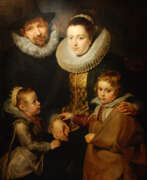

Jan Brueghel the Elder, a Flemish painter born in 1568 in Brussels, was a pivotal figure in the Baroque period known for his intricate landscapes, detailed still lifes, and genre scenes. The son of Pieter Bruegel the Elder, Jan was distinguished by his delicate brushwork, earning him the nicknames "Velvet" Brueghel, "Flower" Brueghel, and "Paradise" Brueghel, each reflecting a different aspect of his versatile artistic output. His monikers refer to his skill in rendering fabrics, his specialization in flower still lifes, and his creation of the paradise landscape genre, respectively.
After early training in Brussels, possibly under the guidance of his grandmother Mayken Verhulst, and further studies in Antwerp, Brueghel ventured to Italy, where he worked in Rome under the patronage of Cardinal Ascanio Colonna and met influential artists like Paul Bril. His Italian sojourn greatly influenced his style, especially in landscape painting. Upon returning to Antwerp, he established a flourishing workshop and became a master in the Guild of St. Luke. Brueghel's collaborations with Peter Paul Rubens are among the most celebrated in art history, showcasing a harmonious blend of landscape and figure painting.
Jan Brueghel the Elder's works are prized for their vibrant depiction of nature and meticulous attention to detail. His landscapes are not just backdrops but are lively settings filled with rich narratives and a variety of creatures, reflecting his deep appreciation for the natural world. His flower pieces are equally renowned for their variety and realism, often serving as allegorical or symbolic representations.
Brueghel's legacy extends beyond his paintings; he was a pivotal figure in the Antwerp artistic community, serving as dean of the Guild of St. Luke and court painter to the Archduke Albert of Austria and the Infanta Isabella Clara Eugenia of Spain. His influence continued through his children, with his son Jan Brueghel the Younger continuing his workshop and maintaining the family's artistic traditions.
For collectors and experts in art and antiques, Jan Brueghel the Elder's works represent a high point in Flemish Baroque art, offering a glimpse into the era's aesthetic values and the artist's profound observation of the world around him. His paintings, found in museums and galleries worldwide, continue to captivate audiences with their beauty and depth.
To stay informed about new discoveries, sales, and auction events related to Jan Brueghel the Elder's work, consider signing up for updates. This subscription will ensure that you are always in the know about opportunities to engage with the enduring art of this Flemish master.
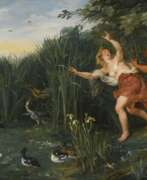

Jan Bruegel the Younger was a Flemish Baroque painter. He was the son of Jan Brueghel the Elder, and grandson of Pieter Bruegel the Elder, both prominent painters who contributed respectively to the development of Renaissance and Baroque painting in the Habsburg Netherlands. Taking over his father's workshop at an early age, he painted the same subjects as his father in a style which was similar to that of his father. He regularly collaborated with leading Flemish painters of his time.
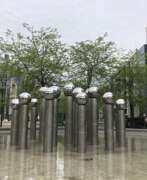

Pol Bury was a Belgian sculptor and artist, celebrated for integrating movement into his sculptures and pioneering the kinetic art movement. Born on April 26, 1922, Bury began as a painter in the Jeune Peintre Belge and the COBRA groups, later transitioning to sculpture. His most renowned work, the fountain-sculpture 'L'Octagon', is a highlight in San Francisco. His innovative art was acknowledged when his work was auctioned at Christie's in 2008, recognizing the unique nature of his contributions to art.
Pol Bury's creations can be found in permanent collections, like that of the Chelsea Art Museum, amongst others.
.
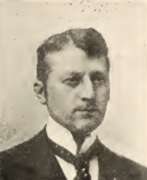

Georges-Léon-Ernest Buysse is a Belgian impressionist and luminist painter. Busset took lessons from the Ghent painter Louis Titgadt. The artist Emil Klaus, who was one of his friends, also gave him a lot of advice. He has participated in exhibitions since 1894. At the 1894 Salon of the National Society of Fine Arts in Paris, he exhibited two canvases on the theme of "snow effects". At that time, his work was focused on landscapes, views of the city of Ghent and gardens of country residences in the vicinity of Ghent. In 1904, Busset was one of the co-founders of the artistic circle Vie et Lumière. His early work was realistic or pre-impressionist. Later, his palette became - under the influence of Emile Claus and after their trip to the south of France - clearer, the work acquired impressionist and luminist features. He adhered to Luminism, in particular as a co-founder of the art circle Vie et Lumière, and used light and lighting effects in his painting.
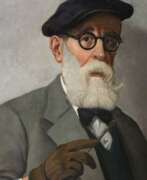

Louis Gustave Cambier is a Belgian painter-painter and sculptor, member of the Royal Academy of Fine Arts in Brussels.
Cambier studied at the Royal Academy of Fine Arts in Brussels and was a co-founder of the Brussels artists' group Le Labeur. During the First World War, he worked as a professor of sculpture at the Académie de Nice and one of his students was Henri Matisse.
Cambier painted landscapes, still lifes and genre scenes, as well as portraits of famous contemporaries, including, for example, a portrait of Winston Churchill.


Théodore-Joseph Canneel was a Belgian portrait and genre painter, lithographer and art teacher. From 1830, Theodore Canneel learned the craft of lithography in the printing shop where his father worked. He then became a student of the painter Pieter van Hanselaere. From 1838 to 1841 he combined his profession with an education at the Koninklijke Acaďemie voor Schone Kunsten van Gent. He taught there from 1843. From 1848 to 1850 he undertook a study trip to France and Italy. On his return in 1850 he was appointed director of the Ghent Academy. In 1869 he became inspector at the Belgian drawing schools and academies. He also became a corresponding member of the Royal Academy of Sciences and Fine Arts of Belgium, the Koninklijke Academie voor Schone Kunsten van Antwerpen and an honorary member of the Philadelphia Academy. For the services rendered, he was appointed officer of the Belgian Order of Leopold.




Jacques François Joseph Carabain was a Dutch-Belgian painter, known primarily for his scenes of cities and buildings in the Romantic-Realist style. He was especially interested in Medieval and Baroque structures, and was often attracted to busy market places.
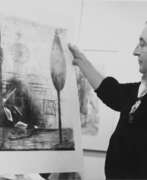

René Carcan was a Belgian painter, engraver, sculptor and jeweler.
He studied sculpture at the Academy of Saint-Josse-Ten-Nod and then painting at the Brussels Academy.
Carcan developed an artistic style that has been compared to Henri Matisse, and the frescoes of Tuscany and Etruria became one of his main sources of inspiration. Carcan was a prolific and polymorphous artist, always eager to experiment. In addition to his work in printmaking, he enjoyed sculpture and jewelry making.


Pieter Casteels III was a Flemish painter, engraver and designer, a member of the Guild of St. Luke in Antwerp.
He was born into the family of the painter Pieter Casteels II or the Younger (1673-1701), who gave his son his first lessons in painting. In 1708 Peter went to London, where he became active in the London art community and a member of the Rose and Crown Club.
Casteells successfully painted numerous floral still lifes with exotic birds, which were favored by the nobility of the time, as well as idyllic scenes with domestic birds and animals. His works were also often used as decorations for fireplaces and doors. The great success of this genre led the artist to publish the Twelve Months of Flowers and Twelve Months of Fruit series - these prints served as models for workers in textiles and other luxury industries.
In 1735 Peter Casteells III retired from painting and turned his attention to textile design, working for the rest of his life for textile manufacturers in Surrey and then London.


Charles Ferdinand Ceramano, born Charles Ferdinand Semain, was a Belgian painter and illustrator of the Barbizon school.
Ceramano's favorite subjects were pastoral landscapes and scenes of sheep in a sheepfold or in a meadow.
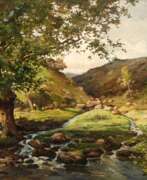

Martin Léonce Chabry is a French painter. Thanks to his contacts and his recognized qualities, Chabry left for Paris as a resident of the City of Bordeaux and in 1854, he entered the studio of Constant Troyon. For two years, Chabry made frequent visits to Barbizon. In 1855, in Barbizon, Chabry met a Belgian-Dutch artist, Willem Roelofs, who invited him to visit Flanders. Following this advice, he settled for some time in Bruges, then visited Brussels in 1856. At that time he often worked with Verwee and Hippolyte Boulenger, in Tervuren, near Brussels. If Chabry can be considered as one of the fathers of the School of Tervueren, thanks will never be given to him in Belgium, "too French", curiously, he suffers in France from being too Belgian. In 1862, he moved to Sauternes, but continued to participate in the annual Brussels fair as well as that of Bordeaux. In 1867, the Bordeaux museum bought his first canvas, followed two years later by the King of the Belgians, Leopold II. In 1881, he undertook a long trip to Egypt, Palestine, Syria. At the end of June 1882, a personal exhibition of his trip to the East opens in Brussels.
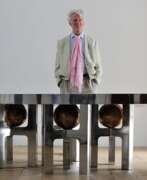

Ado Chale is a Belgian artist and designer best known for his exquisite mosaic inlays. Pieces of wood, minerals, or bone are sliced, arranged, and coated with resin to form the opulent surfaces. His furniture and domestic objects reference the natural world not only through the use of precious stones, metals, and organic materials, but also through the textures, patterns, and forms they express. Chale opened his first gallery in 1962. He exhibited jewelry and small side tables adorned with his unique inlay and sourced various gems and rocks via international travel. The self-taught craftsman then incorporated his acquisitions into larger pieces of furniture and sculptures attractive for their beauty and novelty in the 1970s. His work has been exhibited at the Ixelles Museum in Belgium, in France at the Museum of Fine Arts in Nancy and the Palais des Papes in Avignon, and in Japan at retail chain Seibu’s contemporary art museum.
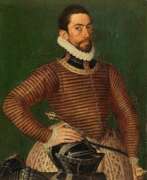

Gillis Claeissens or Egidius Claeissens was a Flemish painter from a dynasty of a famous family of artists from Bruges.
Gillis trained in the studio of his father, Pieter Claeissens, worked at the court of Alexander Farnese in Brussels, and later was court painter to Archdukes Albert and Isabella. He painted religious paintings for the Brussels court, as well as miniature portraits of the Archduchess.
Gillis was a master of portraits, as well as of prostrate images. His portrait paintings are distinguished by the careful painting of the clothes and jewelry of people whose poses are usually static and whose faces are inexpressive.
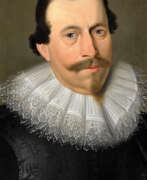

Pieter Claesz was a Dutch Golden Age painter of still lifes.
He and Willem Claeszoon Heda, who also worked in Haarlem, were the most important exponents of the "ontbijt" or dinner piece. They painted with subdued, virtually monochromatic palettes, the subtle handling of light and texture being the prime means of expression. Claesz generally chose objects of a more hospitable kind than Heda, although his later work became more colourful and decorative. Claesz's still lifes often suggest allegorical purpose, with skulls serving as reminders of human mortality. The two men founded a distinguished tradition of still life painting in Haarlem. Pieter Claesz was influenced by the artist movement 'Vanitas'.


Alfred Jean Andre Cluysenaar was a Belgian Portrait painter. Jean Alfred was a member of the Cluysenaar family, an artistic family from Brussels. He became the father of the painter André Cluysenaar. He studied in the Académie Royale des Beaux-Arts of Brussels in the atelier of Joseph Jaquet and François-Joseph Navez. He painted some important decorations in the Royal Zoo of Antwerp and in 1861-1876 he ornated the Aula in Ghent. Cluysenaar was famous for his monumental decorations of high quality. Awarded in the expositions of Brussels, Ghent, Paris Vienna and London. Some of his paintings are kept in the Royal Museum of Fine Arts Antwerp.
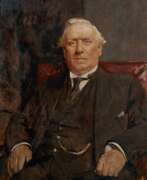

André Edmond Alfred Cluysenaar was a Belgian painter. He was especially known for portraits and female figures. He was member of the Cluysenaar family, descendant from a long line of architects who originated in Aachen. He received his first art lessons from his father, then studied with François-Joseph Navez. Initially, he worked as a sculptor, but devoted himself entirely to painting after 1902. He was firmly grounded in the romantic style at first; producing still lifes and genre scenes, but later turned to impressionism and painted mostly female figures, often semi-nude. He also executed monumental ceiling paintings for the City Hall in Saint-Gilles. During World War I, he lived in London where he established a reputation painting portraits of notable people, including the Royal Family, which were done in a more commercial style using Alfred Stevens as a model. Most of these portraits may be seen in the National Gallery.


Marie Collart-Henrotin was a Belgian artist who mainly painted landscapes and animals. Collart was primarily self-taught as an artist. She became a founding member of the Société Libre des Beaux-Arts in 1868. In 1870, she won a gold medal at the Salon des artistes français. She became the first women to be named a Chevalier in the Belgian Order of Leopold in 1880. Collart exhibited her work at the Palace of Fine Arts and The Woman's Building at the 1893 World's Columbian Exposition in Chicago, Illinois. Her work is included in the collections of the Royal Museum of Fine Arts Antwerp and Royal Museums of Fine Arts of Belgium.


Alexander Coosemans was a Flemish painter of the Baroque period.
Coosemans studied under the masters of still life painting and became a member of the Guild of St. Luke of Antwerp in 1645.
Coosemans painted lush, fruit- and flower-rich still lifes, vanitas-style still lifes that evoke the transience of life. His compositions are often thought to have hidden, allegorical meanings: lobsters, wine and lemons - each subject is filled with references to biblical themes and history.
In collaboration with other artists, Coosemans created so-called garland paintings - a portrait or religious subject surrounded by garlands of flowers and fruit. The artist also decorated the villas of the nobility of Genoa and Rome with his works.


Joseph Théodore Coosemans was a Belgian landscape painter. Under the influence of Théodore Fourmois, he decided to specialize in landscapes. He held his first exhibition in 1863. In 1868, he was one of the co-founders of the Société Libre des Beaux-Arts. After 1872, he devoted himself exclusively to painting. During this time, he became one of the first members of an artists' group known as the School van Tervuren. He made visits to Normandy with Alfred Verwée and Louis Dubois, and spent a short time at Barbizon. While there, he created some works in the style of the Barbizon School. His own style gradually evolved from that of Fourmois to a simpler approach, reminiscent of Hippolyte Boulenger, his patron at Tervuren. In 1887, he was named a Professor of landscape painting at the Royal Academy of Fine Arts in Antwerp.
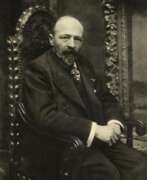

Franciscus Eduardus Maria (Franz) Courtens (1854–1943) was a Belgian painter. He was a leading figure in the Dendermonde School, famous for his paintings of nature and landscapes. Courtens was professor at the Royal Academy of Fine Arts (NHISKA) in Antwerp from 1904 till 1924. He was a personal friend of Leopold II, who gave him the privilege of free access to the royal Parc of Laeken. Some of his paintings stil remain in the Royal collection.


Herman Courtens was a Belgian painter. Herman Courtens was son of Franz Courtens who became his first teacher. He was also a student of Isidore Verheyden at the Academy of Fine Arts in Brussels. He became a teacher at the Higher Institute of Fine Arts in Antwerp. This was the perfection after the ordinary Academy studies. Herman Courtens painted figures, genre scenes, portraits, landscapes, flowers and interiors. His works often have a somewhat busy, overloaded image.




